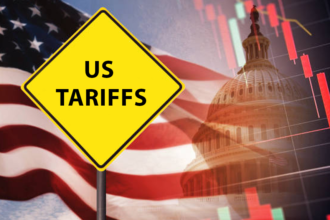An AWS outage on October 20, 2025, sent shockwaves through the global digital economy. Amazon Web Services (AWS) — the backbone of countless websites, applications, and enterprise systems — suffered a serious failure in its U.S. East 1 region in Northern Virginia.
- AWS Outage Impacts Amazon Stock and Investor Sentiment
- AWS Outage Exposes Fragile Digital Infrastructure
- AWS Outage Raises Earnings Pressure on Amazon
- AWS Outage Highlights Amazon’s Cost-Cutting Efforts
- AWS Outage Highlights Concentration Risk in Cloud Sector
- AWS Outage Pushes Businesses Toward Multi-Region Resilience
- AWS Outage Reveals Market Sensitivity to Cloud Shocks
- AWS Outage Exposes Internet’s Centralized Weak Points
- AWS Outage Underscores the True Cost of Convenience
- AWS Outage Spurs Industry Shift Toward Resilient Future
- AWS Outage: A Final Lesson in Risk and Resilience
- FAQs
Within minutes, the service disruption rippled around the world. Popular platforms, including Snapchat, Coinbase, Robinhood, Disney+, and United Airlines, went offline or became unstable. Even Amazon’s own services, such as Prime Video, Alexa, Ring, and Amazon.com, were affected.
For millions of users, this wasn’t just a momentary technical problem. It was a stark reminder of how deeply the internet relies on a single set of cloud infrastructure nodes. When a critical region falters, the world notices.
Amazon engineers quickly began investigating. The company confirmed “increased error rates” and “delays” in key services. While AWS provided updates every 45 minutes, the global impact underscored how fragile modern cloud-based systems can be. This AWS downtime also raised new questions about how prepared the world really is for major cloud failures.
AWS Outage Impacts Amazon Stock and Investor Sentiment
The AWS outage was not just a technical incident; it was also a financial event. Amazon’s stock (AMZN) slipped in pre-market trading following the news. Investors were already watching the company closely ahead of its Q3 earnings report on October 23, 2025.
Amazon’s performance has lagged behind key indices this year. While the Nasdaq 100 and S&P 500 have gained 15% to 20%, Amazon’s shares have seen a slight decline. This underperformance has increased investor sensitivity to any operational hiccups — especially involving AWS, Amazon’s most profitable division.
Despite the outage, analysts remain cautiously optimistic. They point to Amazon’s aggressive AI infrastructure investments, long-term leadership in cloud services, and strategic expansion of its data center network. But they also acknowledge that another large-scale AWS downtime could significantly impact investor confidence if not addressed properly.
AWS Outage Exposes Fragile Digital Infrastructure
The AWS outage revealed how vulnerable today’s internet infrastructure is. Major platforms like McDonald’s, Snapchat, and Robinhood experienced service failures, while Fortnite and Roblox players were abruptly disconnected mid-match.
Many businesses rely on the U.S. East 1 region because of its speed, affordability, and deep integration with AWS tools. But that same concentration creates a single point of failure. Once this hub experienced technical issues, it caused cascading impacts on dependent applications worldwide.
Amazon’s operations team responded quickly. By mid-morning, engineers reported “significant signs of recovery,” but traffic was throttled to reduce strain. Meanwhile, millions of users faced unresponsive services, transaction delays, or complete downtime.
This kind of cloud service disruption highlights the need for stronger redundancy strategies — not just for AWS customers, but for the broader digital ecosystem.
AWS Outage Raises Earnings Pressure on Amazon
The AWS outage couldn’t have come at a worse time for Amazon. The company’s cloud division has been facing increasing competition and shrinking margins. In the June quarter, AWS reported 17% year-over-year growth, falling short of the 20% expected by analysts.
Operating margins also fell sharply from 39.5% to 32.9%, largely due to a massive $31.3 billion investment in property and equipment — the highest in its history. This spending reflects Amazon’s bet on AI infrastructure, data centers, and global cloud expansion.
The upcoming earnings report is critical. A rebound in AWS growth or improvement in capacity utilization could reassure investors and offset concerns raised by this outage. But a weak performance would magnify the perception of vulnerability at a time when Microsoft Azure and Google Cloud are gaining ground.
For Amazon leadership, including CEO Andy Jassy, the pressure is on to prove that the company can strengthen both its infrastructure and its profitability despite incidents like this.
AWS Outage Highlights Amazon’s Cost-Cutting Efforts
The AWS outage also cast a new spotlight on Amazon’s cost-control strategies. Earlier this year, the company announced plans to lay off up to 15% of its HR workforce, focusing on the PXT (People eXperience Technology) division.
These job cuts follow a broader cost-cutting strategy that began in late 2022, when Amazon eliminated 27,000 corporate jobs — the largest layoff in company history. This restructuring reflects CEO Andy Jassy’s push to make Amazon leaner and more efficient, while redirecting resources toward AI and cloud infrastructure.
However, some analysts worry that aggressive cost reductions could stretch engineering and support teams thin. When major incidents occur, rapid response depends on robust, well-resourced technical teams. This AWS downtime is likely to reignite internal and external debates about how lean the company can afford to become.
Meanwhile, Amazon continues its seasonal hiring spree for warehouse and logistics workers — adding 250,000 temporary staff ahead of the holiday season — highlighting its dual strategy of cost efficiency and operational scaling. Read another article on Asian stock markets plunge
AWS Outage Highlights Concentration Risk in Cloud Sector
The AWS downtime has reawakened concerns about concentration risk in the global cloud market. A small number of hyperscalers — AWS, Microsoft Azure, and Google Cloud — handle the majority of online traffic.
When a single region in one of these networks fails, millions of businesses and consumers feel the impact almost instantly. The outage caused visible market ripples: Snapchat messaging faltered, Robinhood trading froze, and Coinbase customers were locked out of their accounts. Even United Airlines experienced delays, labeling the issue as a “system glitch.”
For investors, this wasn’t just a technical story. It was a risk exposure event. Businesses that depend heavily on one cloud provider face amplified vulnerabilities. And when hyperscalers stumble, global markets notice — and react.
AWS Outage Pushes Businesses Toward Multi-Region Resilience
The AWS outage underscored the importance of multi-region redundancy in cloud strategy. Many companies build their infrastructure in U.S. East 1 because it’s cheaper and faster. But as this incident showed, concentrating workloads in a single location is risky.
Experts recommend distributing services across multiple AWS regions or even across different cloud providers such as Google Cloud and Microsoft Azure. This approach, known as multi-cloud architecture, can significantly reduce the impact of localized failures.
Amazon itself has promised new investments to enhance resilience, capacity upgrades, and AI-driven load management systems. Still, the AWS downtime proved that even the world’s largest cloud provider isn’t immune to cascading failures.
This event may accelerate industry-wide adoption of disaster recovery strategies, geo-redundant hosting, and failover mechanisms that allow businesses to keep running even when one region experiences trouble.
AWS Outage Reveals Market Sensitivity to Cloud Shocks
The AWS downtime illustrated how financial markets respond to cloud service interruptions. A few hours of downtime reverberated across industries ranging from e-commerce to aviation, gaming, and fintech.
Amazon stock dipped as traders reacted to early reports, while shares of Snap, Robinhood, and other affected companies fluctuated as well. Though markets stabilized after Amazon reported signs of recovery, the event highlighted just how dependent modern economies are on stable cloud infrastructure.
The timing made it even more sensitive: Amazon is preparing to report earnings while making record-high AI and data center investments. Analysts say investors will be watching for management’s explanation of what happened, how they plan to prevent repeats, and whether capital expenditures are being directed effectively.
AWS Outage Exposes Internet’s Centralized Weak Points
The AWS downtime also revealed something bigger than just a temporary failure: the structural centralization of the internet. While the web seems vast and distributed, much of it runs through a handful of physical data centers — many of them clustered in Northern Virginia.
One failure in this cluster silenced billions of clicks, froze transactions, and left users staring at loading screens. This isn’t new — similar incidents in 2021 and 2023 had already raised concerns — but this was one of the most widespread service disruptions in recent memory.
Cybersecurity and network experts argue that transparency, failover testing, and load balancing need to improve across the industry. Governments and regulators may also step in to encourage — or even mandate — more diversified infrastructure to reduce national and economic risk.
AWS Outage Underscores the True Cost of Convenience
The AWS outage of October 20, 2025, wasn’t just a brief inconvenience — it was a stress test for the cloud era. A single region’s failure affected major platforms like Snapchat, Coinbase, Robinhood, Fortnite, and Disney+ Plus, disrupting businesses and everyday digital life.
Although Amazon’s engineers stabilized systems within hours, the timing amplified its impact. It came just before earnings season, amid rising AI spending, heightened cloud competition, and increased investor scrutiny.
This event underscored an uncomfortable truth: the convenience of centralized cloud computing comes with real risks. For users, it meant a frustrating morning. For businesses, it meant lost productivity and revenue. For investors, it was a reminder that cloud infrastructure, though powerful, can also be a single point of failure.
AWS Outage Spurs Industry Shift Toward Resilient Future
In the aftermath of this AWS downtime, industry leaders, CIOs, and investors are likely to rethink their cloud strategies. Expect renewed emphasis on redundancy, multi-region backups, AI-powered traffic management, and alternative hosting providers.
Amazon has already signaled plans to boost infrastructure investment and improve outage detection and response mechanisms. Competitors, meanwhile, will seize the moment to promote multi-cloud solutions, offering companies alternatives to relying on a single provider.
This could reshape the competitive landscape in the cloud industry over the coming years. While AWS remains dominant, outages like this accelerate diversification — which ultimately strengthens the global internet’s resilience.
AWS Outage: A Final Lesson in Risk and Resilience
The AWS downtime is more than just a headline. It’s a warning signal about the fragility of modern digital life. It showed how a technical fault in one region could ground planes, interrupt payments, disrupt entertainment, and rattle financial markets in real time.
For Amazon, this is a challenge — but also an opportunity to lead the way in building a more resilient cloud infrastructure. For businesses, it’s a clear sign that diversification and disaster planning are no longer optional. And for investors, it’s a reminder that technological convenience always comes with underlying risk.
As the world grows more connected, the lessons of this AWS outage will shape how industries, governments, and enterprises approach digital resilience for years to come.
FAQs
- What caused the AWS outage?
A network failure in the U.S. East region triggered a major service disruption, affecting Amazon platforms and global apps.
- Is Amazon experiencing an outage right now?
No, Amazon services are stable at the moment. Users can check real-time updates on the AWS status dashboard.
- Was AWS affected by the CrowdStrike outage?
No, the AWS outage was unrelated to CrowdStrike. Both incidents highlight the vulnerability of global cloud systems.
- When was the big AWS outage?
The major outage occurred recently, disrupting Amazon services and several top apps worldwide.








